When searching for the best electric guitars for jazz, discerning musicians know that tone, playability, and craftsmanship matter more than flashy aesthetics. Jazz guitarists require instruments that deliver warm, rich tones with exceptional clarity across all registers, whether you’re playing silky smooth chord progressions or lightning-fast bebop lines. The right jazz guitar becomes an extension of your musical voice, offering the dynamic range and tonal versatility that this sophisticated genre demands.
Unlike other musical styles that might prioritize aggressive pickup output or extreme sustain, jazz guitar focuses on nuanced expression and tonal complexity. The best jazz guitars typically feature hollow or semi-hollow bodies that provide natural acoustic resonance, paired with pickups that capture every subtle inflection of your playing. From the legendary archtops that defined the golden age of jazz to modern interpretations that push the boundaries of traditional design, today’s market offers exceptional options for players at every level.
Whether you’re a seasoned professional performing in intimate jazz clubs or an aspiring musician exploring the rich world of jazz harmony, selecting the right instrument can dramatically impact your musical journey. The guitars featured in this guide represent the pinnacle of jazz guitar design, combining time-tested construction methods with modern innovations. Each instrument offers its own unique character while maintaining the essential qualities that make a guitar truly suitable for jazz performance.
| Guitar Model | Key Features | Tone & Playability | Best For |
|---|---|---|---|
| Gibson ES-175 | Laminated maple semi-hollow body, dual humbuckers, 24.75″ scale, ebony fingerboard | Warm, round jazz tones with great dynamic response; smooth playability for chords & solos | Professional jazz players seeking authentic vintage tone |
| Ibanez Artcore AS73 | Laminated maple body, Classic Elite humbuckers, mahogany set neck | Balanced warm tone with clarity; excellent sustain and comfort straight from factory | Intermediate to pro players wanting high value at low cost |
| Epiphone Emperor Swingster | Full-hollow laminated maple, P90 PRO pickups, Bigsby vibrato, 25.5″ scale | Bright, responsive tones with vintage character; great dynamic sensitivity | Players wanting a unique jazz tone with vintage flair |
| D’Angelico Premier DC | Semi-hollow maple body, Seymour Duncan 59 humbuckers, 25″ scale | Versatile warm-to-modern tones; smooth C-shaped neck and elegant design | Jazz & fusion guitarists desiring modern tone with heritage styling |
| PRS SE Hollowbody II | Maple top, mahogany back/sides, 58/15 “S” pickups, coil-tap, Wide Fat neck | Warm and clear with coil-tap versatility; exceptional sustain and craftsmanship | Players seeking a modern, versatile jazz guitar with PRS quality |
Gibson ES-175
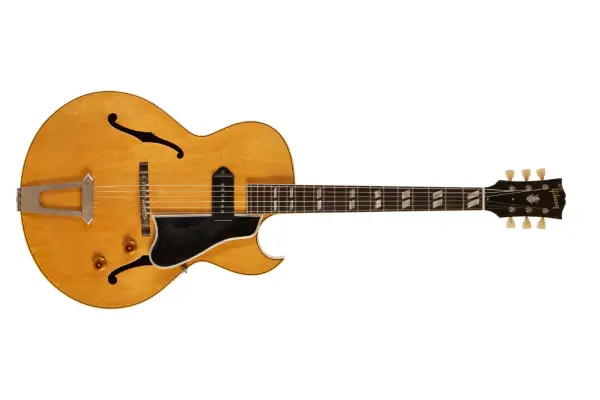
The Gibson ES-175 stands as perhaps the most iconic jazz guitar ever created, earning its legendary status through decades of use by jazz masters like Joe Pass, Pat Metheny, and Jim Hall. This semi-hollow body masterpiece features a laminated maple body with a solid maple center block, creating the perfect balance between acoustic resonance and feedback resistance that jazz guitarists crave. The guitar’s 24.75-inch scale length and comfortable neck profile make it incredibly playable for both rhythm work and intricate single-note passages.
What sets the ES-175 apart is its remarkable tonal versatility, delivered through dual humbucker pickups that capture the full spectrum of jazz expression. The neck pickup produces those signature warm, round tones perfect for chord melodies and ballads, while the bridge pickup offers more clarity and definition for cutting through ensemble arrangements. The guitar’s natural compression and dynamic response allow players to achieve everything from whisper-quiet passages to powerful, cutting leads simply through picking technique and volume control adjustments.
Built with Gibson’s traditional craftsmanship standards, the ES-175 features a bound ebony fingerboard with pearl block inlays, gold-plated hardware, and the company’s legendary tune-o-matic bridge system. While certainly an investment, the ES-175’s build quality, tone, and historical significance make it an instrument that holds its value while inspiring countless hours of musical exploration. For serious jazz guitarists seeking an instrument with authentic vintage character and professional performance capabilities, the ES-175 remains the gold standard.
Ibanez Artcore AS73
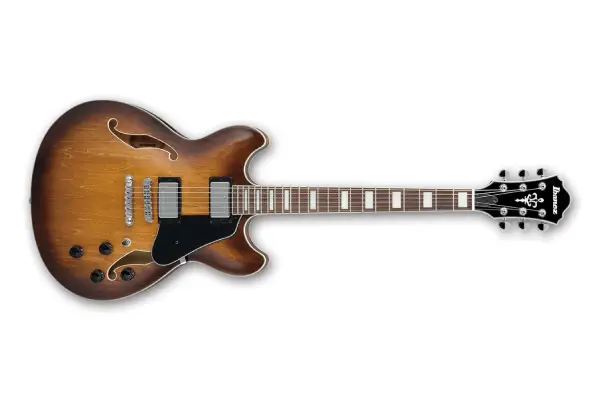
The Ibanez Artcore AS73 represents exceptional value in the semi-hollow jazz guitar market, offering many of the tonal characteristics found in much more expensive instruments at a fraction of the cost. This guitar features a laminated maple body with a solid center block, providing excellent sustain and feedback resistance while maintaining the warm, woody tone that jazz players demand. The bound rosewood fingerboard and classic f-hole design give the AS73 an authentic vintage aesthetic that looks as good as it sounds.
Equipped with Ibanez’s own Classic Elite humbuckers, the AS73 delivers surprisingly sophisticated tones that rival pickups found on guitars costing twice as much. The neck pickup excels at producing smooth, creamy tones perfect for chord work and melodic playing, while the bridge pickup offers enough clarity and punch for cutting through dense musical arrangements. The guitar’s mahogany set neck provides excellent sustain and upper fret access, making it equally suitable for traditional jazz styles and more contemporary fusion approaches.
What makes the AS73 particularly appealing is its exceptional playability straight from the factory, with a comfortable neck profile that accommodates various playing styles and hand sizes. The guitar’s hardware, including the tune-o-matic bridge and stopbar tailpiece, provides reliable tuning stability and contributes to the instrument’s impressive sustain characteristics. For intermediate players looking to step up to a quality jazz guitar without breaking the bank, or professionals seeking a reliable backup instrument, the AS73 offers remarkable value and performance that punches well above its weight class.
Epiphone Emperor Swingster
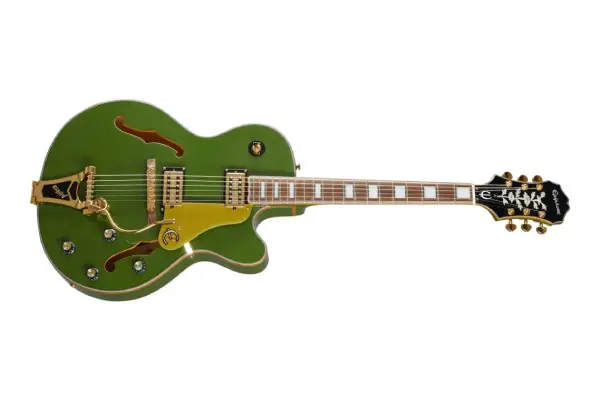
The Epiphone Emperor Swingster brings a fresh perspective to traditional jazz guitar design while maintaining the essential tonal characteristics that define the genre. This full-hollow body guitar features a laminated maple construction with elegant appointments that include gold hardware, pearloid block inlays, and distinctive “cat’s eye” sound holes that provide both visual appeal and enhanced acoustic projection. The guitar’s 25.5-inch scale length offers slightly more string tension than traditional Gibson-scale instruments, resulting in improved clarity and note definition.
The Swingster’s pickup configuration sets it apart from conventional jazz guitars, featuring Epiphone’s P90 PRO single-coil pickups that deliver a unique blend of warmth and clarity. These pickups provide excellent dynamic response and touch sensitivity, allowing players to achieve a wide range of tones through picking technique alone. The neck pickup produces rich, full tones perfect for chord work, while the bridge pickup offers enough bite and presence for lead playing without becoming harsh or overly aggressive.
Built with attention to detail that reflects Epiphone’s commitment to quality, the Emperor Swingster features a comfortable SlimTaper neck profile that facilitates both rhythm playing and single-note work. The guitar’s Bigsby vibrato system adds vintage charm and provides subtle pitch modulation capabilities that can enhance both lead and rhythm playing. While the Emperor Swingster may not follow traditional jazz guitar conventions, its unique voice and exceptional build quality make it an intriguing option for players seeking something different while still maintaining jazz credibility.
D’Angelico Premier DC
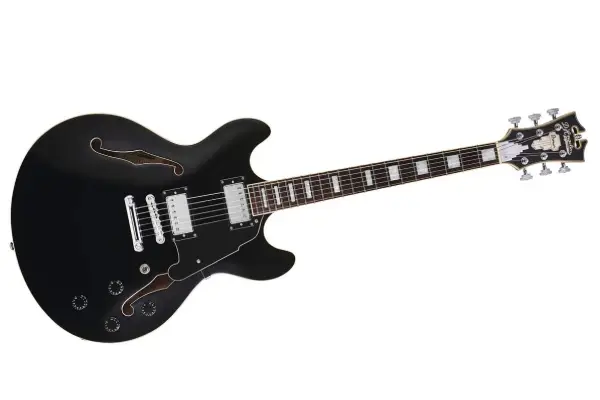
D’Angelico’s Premier DC represents a modern interpretation of the company’s legendary archtop heritage, combining classic aesthetics with contemporary features that appeal to today’s jazz guitarists. This semi-hollow body guitar features a laminated maple body with a solid center block, providing excellent sustain and feedback resistance while maintaining the acoustic qualities that make hollow-body guitars so appealing. The guitar’s art deco-inspired appointments, including the distinctive headstock design and elegant f-holes, pay homage to D’Angelico’s rich history while establishing a unique visual identity.
The Premier DC’s Seymour Duncan 59 humbucker pickups deliver exceptional tonal versatility, offering everything from warm, vintage jazz tones to more contemporary sounds suitable for fusion and modern jazz styles. These pickups are renowned for their balanced frequency response and dynamic sensitivity, allowing players to achieve subtle tonal variations through playing technique. The guitar’s 25-inch scale length represents a compromise between Gibson and Fender specifications, providing slightly more string tension than traditional jazz guitars while maintaining comfortable playability.
Quality construction details throughout the Premier DC reflect D’Angelico’s commitment to craftsmanship, including a bound ebony fingerboard with mother-of-pearl inlays, premium hardware, and meticulous attention to fit and finish. The guitar’s C-shaped neck profile accommodates various playing styles while providing enough substance for excellent sustain and stability. For players seeking a jazz guitar with distinctive character, modern features, and exceptional build quality, the Premier DC offers an compelling alternative to more traditional options while honoring the legacy of one of America’s greatest guitar builders.
PRS SE Hollowbody II
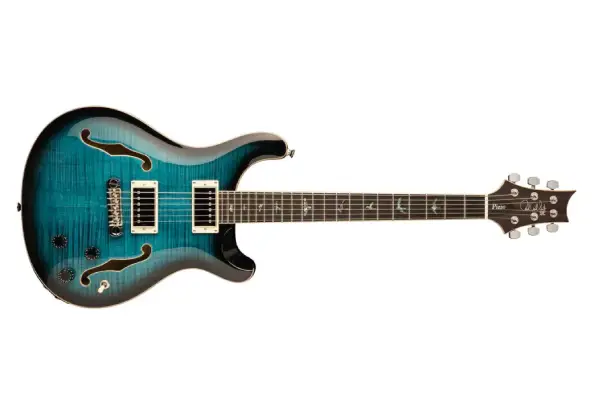
The PRS SE Hollowbody II demonstrates Paul Reed Smith’s unique approach to jazz guitar design, combining traditional hollow-body construction with modern innovations that enhance both playability and tonal versatility. This guitar features a laminated maple body with mahogany back and sides, creating a tonal foundation that emphasizes warmth and woody resonance while maintaining excellent note clarity. The guitar’s distinctive bird inlays, flame maple veneer top, and elegant binding showcase PRS’s attention to visual detail and craftsmanship standards.
Equipped with PRS’s own 58/15 “S” pickups, the SE Hollowbody II offers remarkable tonal flexibility that extends well beyond traditional jazz applications. These pickups provide excellent clarity and definition while maintaining the warmth and depth that jazz players require, with coil-tap functionality that adds single-coil tones to the guitar’s sonic palette. The neck pickup excels at producing rich, full tones perfect for chord work and melodic playing, while the bridge pickup offers enough presence and articulation for cutting through ensemble arrangements without becoming harsh or sterile.
The SE Hollowbody II’s Wide Fat neck profile provides substantial feel and excellent sustain characteristics while remaining comfortable for extended playing sessions. Premium appointments include a bound ebony fingerboard, locking tuners for enhanced tuning stability, and PRS’s proprietary bridge and tailpiece system that contributes to the guitar’s impressive sustain and intonation accuracy. While PRS may be better known for rock and blues instruments, the SE Hollowbody II proves that the company’s design philosophy translates beautifully to jazz applications, offering players a modern alternative that doesn’t sacrifice traditional jazz guitar qualities. You can explore more about different instruments and their unique characteristics across various musical genres.
What Makes a Great Jazz Guitar?
Understanding the essential characteristics that define a great jazz guitar helps players make informed decisions when selecting their next instrument. Traditional jazz guitar design emphasizes hollow or semi-hollow body construction that provides natural acoustic resonance and woody warmth. This construction type allows the guitar to produce rich harmonic overtones and natural compression that complement jazz’s emphasis on tonal subtlety and dynamic expression. The acoustic properties of hollow-body guitars also contribute to their distinctive “breathy” attack and natural decay characteristics that have become synonymous with authentic jazz tone.
Pickup selection plays a crucial role in determining a jazz guitar’s sonic character, with most professionals preferring humbucker pickups that provide warm, full tones with minimal noise and excellent frequency balance. Quality jazz guitar pickups should capture the instrument’s natural acoustic properties while adding their own tonal coloration that enhances rather than masks the guitar’s inherent voice. The best jazz guitar pickups respond dynamically to playing technique, allowing musicians to achieve a wide range of tonal colors through subtle changes in picking attack, hand position, and playing dynamics.
Playability factors including neck profile, scale length, and fretboard radius significantly impact a guitar’s suitability for jazz performance. Most jazz guitarists prefer medium neck profiles that provide enough substance for excellent sustain while remaining comfortable for extended playing sessions. The fingerboard should facilitate both complex chord work and intricate single-note passages, with fret size and spacing that accommodates the precise finger placement required for jazz harmony and improvisation. Additionally, premium songs often showcase how these tonal characteristics translate into memorable musical performances.
Choosing the Right Jazz Guitar for Your Style
Selecting the perfect jazz guitar requires careful consideration of your playing style, musical preferences, and performance requirements. Traditional jazz players who focus on standards, swing, and bebop typically gravitate toward classic archtop designs with warm, woody tones that complement the genre’s harmonic sophistication. These players often prefer guitars with pronounced midrange presence and natural compression that allows for expressive chord work and melodic interpretation. The ability to achieve both rhythm and lead tones from the same instrument becomes particularly important for solo jazz guitarists who need to seamlessly transition between accompaniment and improvisation roles.
Contemporary jazz and fusion players may require instruments with broader tonal versatility and enhanced clarity for more complex harmonic structures and modern playing techniques. These musicians often benefit from guitars that offer both traditional jazz tones and more contemporary sounds suitable for electric and acoustic ensemble work. Features like coil-tap pickups, extended range capabilities, and modern neck profiles can enhance the instrument’s versatility without compromising its essential jazz character.
Budget considerations also play a significant role in jazz guitar selection, with quality instruments available across various price ranges. Entry-level players should focus on guitars that offer good basic tone and playability while leaving room for future upgrades as their skills develop. Intermediate and professional players typically benefit from investing in higher-quality instruments that provide superior tone, craftsmanship, and long-term reliability. Remember that a well-chosen jazz guitar becomes a lifelong musical partner, making it worthwhile to invest in the best instrument your budget allows. When making comparisons between different models, consider reading our detailed headphone comparisons to understand how proper monitoring equipment can help you evaluate these instruments more effectively.
Maintenance and Care for Jazz Guitars
Proper maintenance and care are essential for preserving your jazz guitar’s tone, playability, and appearance throughout its lifetime. Hollow and semi-hollow body guitars require special attention due to their acoustic properties and delicate construction details. Regular cleaning with appropriate guitar care products helps maintain the instrument’s finish while preventing the buildup of dirt and oils that can affect both appearance and tone. Pay particular attention to the f-holes and internal areas where dust and debris can accumulate over time, potentially dampening the guitar’s acoustic resonance.
String maintenance plays a crucial role in preserving your jazz guitar’s tone and playability, with most professionals recommending regular string changes based on playing frequency and environmental conditions. High-quality flatwound strings remain popular among traditional jazz players for their smooth feel and warm tone, while roundwound strings offer enhanced brightness and sustain for more contemporary styles. Proper string installation and stretching techniques help ensure stable tuning and optimal tone quality, while regular cleaning extends string life and maintains consistent feel.
Environmental factors such as humidity and temperature fluctuations can significantly impact hollow-body guitars, making proper storage and climate control important considerations. Maintain consistent humidity levels between 45-55% to prevent finish cracking, neck warping, and other moisture-related issues. Professional setups should be performed regularly to maintain optimal action, intonation, and overall playability, with adjustments made as needed for seasonal changes and normal settling. Investing in quality accessories like earbuds for practice sessions can help you maintain better awareness of your instrument’s tonal characteristics during maintenance routines.
Conclusion
The quest for the perfect jazz guitar is deeply personal, with each musician’s unique style, preferences, and requirements influencing their ideal choice. The five instruments featured in this guide represent different approaches to jazz guitar design, from traditional archtop excellence to modern interpretations that push creative boundaries while maintaining essential jazz characteristics. Whether you choose the legendary Gibson ES-175 with its time-tested design and professional pedigree, or opt for the exceptional value offered by the Ibanez Artcore AS73, each guitar provides a solid foundation for jazz expression and musical growth.
The most important factor in selecting a jazz guitar is finding an instrument that inspires your playing and complements your musical voice. Take time to play multiple instruments, experiment with different pickup configurations, and consider how each guitar’s unique characteristics align with your musical goals. Remember that the best jazz guitar is one that encourages you to explore new harmonic territories, develop your improvisational skills, and express your musical ideas with clarity and emotion.
Ultimately, these instruments represent gateways to the rich world of jazz expression, each offering its own path toward musical discovery and artistic development. Whether you’re drawn to vintage warmth, modern versatility, or somewhere in between, the right jazz guitar will become an essential partner in your musical journey, providing years of inspiration and countless opportunities for creative expression.
Frequently Asked Questions
What’s the difference between hollow body and semi-hollow body jazz guitars?
Hollow body guitars feature completely hollow construction without a center block, providing maximum acoustic resonance and natural warmth but with higher feedback potential at loud volumes. Semi-hollow body guitars include a solid center block that reduces feedback while maintaining much of the acoustic character, making them more versatile for different performance situations.
Are expensive jazz guitars really worth the investment for beginners?
While expensive guitars offer superior tone and craftsmanship, beginners should focus on instruments that provide good basic tone and playability within their budget. Quality entry-level options like the Ibanez Artcore series offer excellent value and allow players to develop their skills before investing in premium instruments.
What pickup types work best for jazz guitar?
Humbucking pickups are generally preferred for jazz applications due to their warm, full tone and noise-canceling properties. However, some players successfully use P90-style single coils or specialized jazz pickups that offer different tonal characteristics while maintaining the warmth and clarity essential for jazz performance.
How important is guitar setup for jazz playing?
Professional setup is crucial for jazz guitars due to the genre’s demanding technical requirements. Proper action, intonation, and pickup height adjustments ensure optimal playability for complex chord voicings and precise single-note work that characterizes jazz performance.
Can I use effects pedals with jazz guitars?
While traditional jazz emphasizes clean, natural guitar tones, many contemporary players successfully incorporate subtle effects like reverb, chorus, and compression. The key is using effects tastefully to enhance rather than mask the guitar’s natural voice and acoustic properties.

